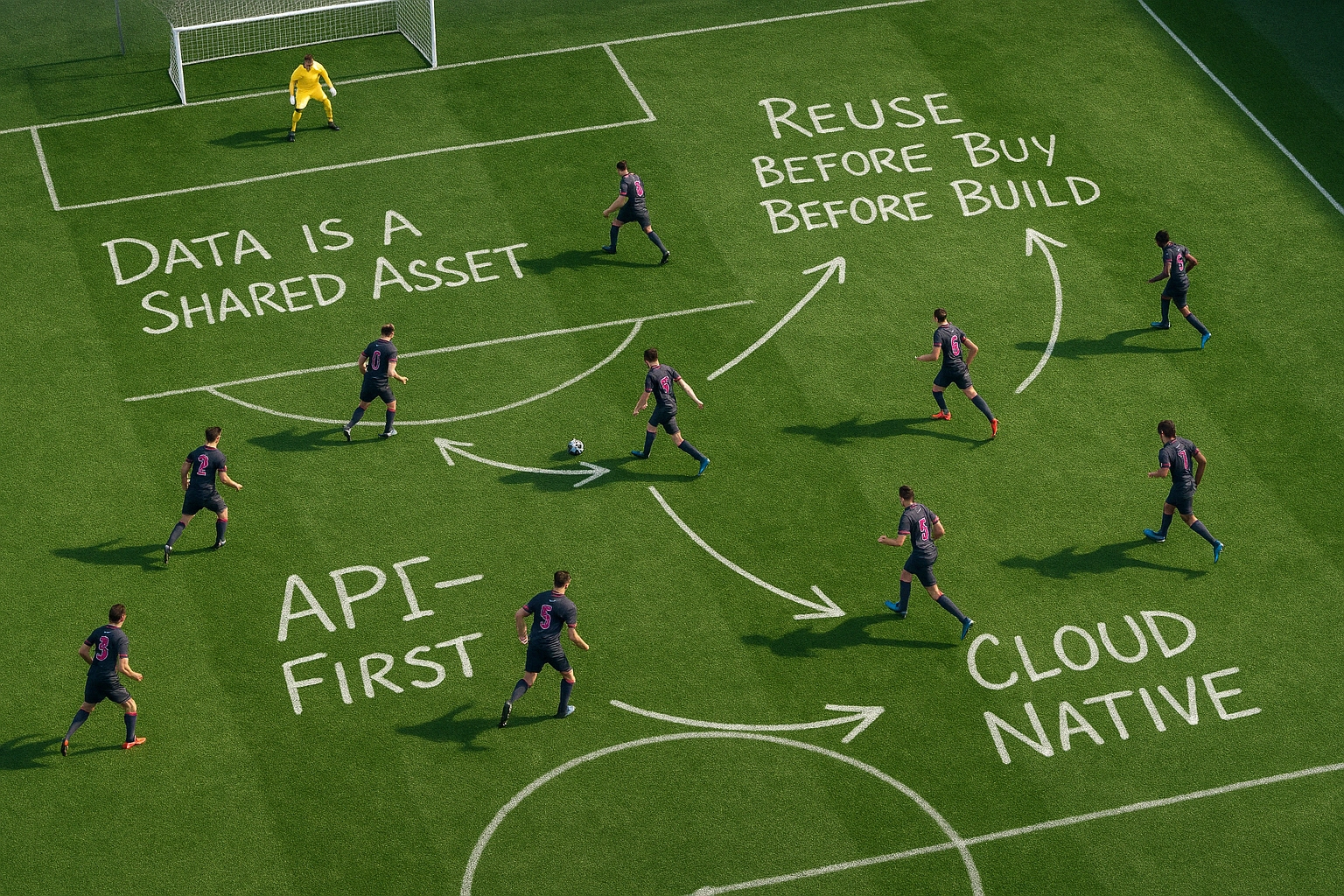
The Architecture Playbook: Principles That Win the Game
Picture a soccer team stepping onto the field, full of talent and energy, but without a playbook. Everyone has their own idea of what the next move should be. Chaos ensues. There are moments of brilliance, but no consistency, no strategy, and ultimately, no win. This is what enterprise transformation looks like without architecture principles. These principles are not just corporate buzzwords or procedural fluff. They are your playbook, the guiding strategies that help every part of your organization move in sync toward a common goal.
Why Principles Matter at the Start
At the inception of any strategic change initiative, whether digital transformation, platform modernization, or cloud migration, stakeholders come to the table with different goals, biases, and interpretations of success. The early phase is filled with optimism but often lacks structure.
This is where architecture principles come into play. They shape the architecture vision by establishing a shared belief system. These principles ensure that decisions made later on are consistent, traceable, and justifiable. In essence, they form the soul of your architecture.
Anatomy of a Good Architecture Principle
Architecture principles are the tactical building blocks of your architectural strategy. Much like the defined plays in a soccer team's manual, principles provide structure without stifling creativity. They create a common vocabulary across business and IT, clarify the rationale behind design choices, and set boundaries within which innovation can flourish.
However, crafting effective principles requires more than just good intentions. They must be actionable, relatable, and robust enough to stand the test of competing priorities. Here’s a breakdown of the essential components that turn a vague idea into a powerful decision-making guide:
| Component | Description |
|---|---|
| Name | A short, powerful label that captures the essence of the principle. Think of it as the team chant everyone remembers. Example: "Data is an Asset." |
| Statement | A clear and concise declaration of the principle. It should be unambiguous and easy to repeat. Example: "Data must be managed as a valuable enterprise asset." |
| Rationale | The reason this principle exists. It connects the principle to business value, strategic goals, or risk mitigation. This is the "why" that earns buy-in. |
| Implications | A list of consequences, trade-offs, or behavioral changes that will result from applying the principle. It helps translate high-level intent into practical actions. |
Think of architecture principles as the playbook for your soccer team. In soccer, the playbook defines formations, tactics, and how the team adapts during the match. It aligns everyone around a shared strategy, so that when the pressure mounts and the game changes, the team executes fluidly and consistently.
If one principle is "Play Wide to Stretch the Field" (think: "Interoperability First"), then players know to use the full width and avoid narrow, rigid structures (akin to avoiding vendor lock-in). If another principle is "Possession Over Chaos" (like "User-Centric Design"), the team is guided to value controlled build-up over flashy but risky moves, ensuring continuity and usability.
In both cases, the team knows how to react not because every situation was pre-scripted, but because the principles give them a shared understanding of what matters.
How to Use Principles to Build Vision
Architecture principles are not static statements. To be effective, they must become embedded in how the organization thinks, plans, and acts from strategic alignment down to operational decision-making. It’s not enough to document principles and file them away. Their power lies in how they shape dialogue, frame trade-offs, and influence technology choices. Here’s how to put them to work:
1. Co-create with Stakeholders
Involve business leaders, security experts, developers, and operations teams early in the process of defining principles. This ensures the principles reflect real-world challenges, win broader support, and avoid ivory tower thinking. Co-creation fosters ownership and drives alignment across the organization.
2. Focus on Strategic Fit
Tailor your principles to the strategic objectives of your organization. Avoid generic principles that could apply to any enterprise. For example, if rapid innovation is a key differentiator, then principles should emphasize agility, speed, and decoupling. Strategic fit makes the principles relevant and resonant.
3. Connect Principles to Value
Articulate how each principle contributes to business goals. For instance, "API-First" might accelerate partner integration, while "Cloud Native" improves scalability and resilience. Tying principles to tangible outcomes helps gain executive sponsorship and stakeholder commitment.
4. Use Principles as Decision Filters
In architectural design reviews, solution evaluations, or vendor selections, apply principles as filters. Ask: does this option align with our principles? Where it doesn't, are the trade-offs acceptable? This practice embeds principles in the rhythm of decision-making.
Visualizing Architecture Principles
Architecture principles are often abstract, making them difficult to internalize and apply. Visualization helps bridge this gap by turning principles into tangible design assets that teams can interact with, debate, and align around. Here are three example diagram types that bring architecture principles to life:
Principles Decision Matrix
A 2x2 grid plotting principles based on their strategic importance vs. implementation complexity. This makes it easier to prioritize which principles to apply first.
Layered Stack Diagram
A vertical stack showing enterprise layers with principles mapped to each. This clarifies where each principle applies.
Cause-Effect Chains
A flowchart-style diagram that links a principle to its downstream effects across people, processes, and technology.
Use these diagrams in vision documents, stakeholder presentations, or governance reviews to reinforce the principles not just as ideas, but as levers of real-world change.
Principles as Strategic Game Plans
Architecture principles are not just artifacts to tick off in documentation. They are behavioral anchors that translate enterprise strategy into day-to-day guidance. When crafted thoughtfully and applied rigorously, they prevent chaos, foster alignment, and help architecture teams deliver more than just technology. They deliver clarity. So next time you step onto the field of architectural change, do not just assemble the players. Write your playbook. Train your formations. Practice your tactics. And prepare to win the match.

